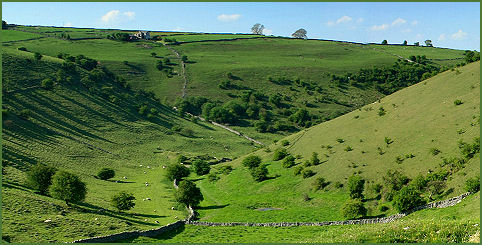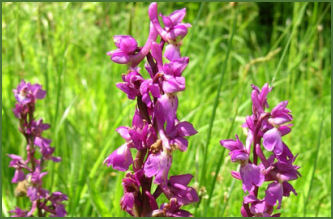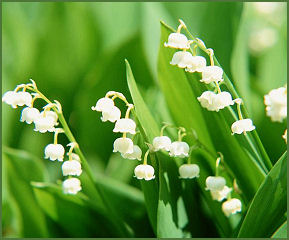Deepdale
OS grid ref:- SK 098716
 Deepdale is situated 4km to the east of the spa town of Buxton in the Peak District National Park.
Deepdale is situated 4km to the east of the spa town of Buxton in the Peak District National Park.
A tributary of the main Wye (river) valley and a superb example of a typical Peak District dry limestone dale, Deepdale contains a plantlife reserve owned by the Derbyshire Wildlife Trust and has recently been awarded SSSI status (Site of Special Scientific Interest). The attractive dale is very popular on account of its wide variety of wildlife.
Romano-British material has been discovered at Thirst House Cave on the Eastern flank of King Sterndale, excavations have revealed that the cave was occupied at various times from the Ice Ages to Roman times. The cave is a natural solution tunnel formed along the bedding plane of the limestone. A small spring lies below the entrance, according to tradition, Hob, a capricious elf, charms the springs waters on Good Friday.
Directions
From Bakewell, take the A6 towards Buxton. Keep on the A6, going past turnings to Ashford in the Water on the right and Sheldon on the left. Approximately 3.5 miles from Bakewell you reach the White Lodge 'pay-and-display' car park and picnic site on the left hand side of the road. To get to the reserve from the car park you should follow the footpath leading southwards. Approximately 200m from the car park you reach a stile, which is one of the entrances to the reserve.
The Wye Dale car park (pay and display) is situated on the A6 road, follow the path to the northern entrance of the reserve. Parking is also available in King Sterndale village and provides access to the centre and south of the reserve.
The flora of Deepdale
 The steeply sloping sides of Deepdale are rich in wild flowers.
The steeply sloping sides of Deepdale are rich in wild flowers.
Springtime brings colourful swathes of early-purple orchids, (pictured opposite right) its dark green leaves have purple black blotches, the flowers are deep pinkish purple verging towards white and it is the first of our native species of orchid to flower each year. In the past, the roots and tubers were sometimes used to make a ’flour’ called salep.
Yellow cowslips, blue harebells, toothwort, lesser celandine, spring cinquefoil and the lovely meadow saxifrage are also present in abundance in the dale in spring.
 These blooms are replaced in the summer by the flowers of sweet scented lily-of-the-valley (left), the elegant purple blooms of columbine, the unusual bird's-nest orchid, mountain pansy, the beautiful sunshine yellow common rock-rose, spring sandwort, rough hawkbit, orange-yellow kidney vetch and the lemon yellow flower heads of mouse-ear hawkweed.
These blooms are replaced in the summer by the flowers of sweet scented lily-of-the-valley (left), the elegant purple blooms of columbine, the unusual bird's-nest orchid, mountain pansy, the beautiful sunshine yellow common rock-rose, spring sandwort, rough hawkbit, orange-yellow kidney vetch and the lemon yellow flower heads of mouse-ear hawkweed.
Towards the end of the summer, a number of late-flowering species begin to bloom in Deepdale, including the rounded and nodding, purple-blue flower heads of Devil’s-bit scabious, its pincushion-like flower heads attract a wide variety of butterflies and bees. The distinctive white flowers of grass-of-Parnassus are also evident at this time of year, also known as the bog star, it is now in decline across regions of Britain.
The reserve is also home to a large number of butterfly species including the green hairsteak, which rests with wings closed showing bright green undersides, while the wings are dull brown on the uppersides, the dingy skipper, which when freshly-emerged, reveals a subtle pattern of browns and greys that is quite beautiful. The colourful peacock , the meadow brown, small copper and dark green fritillary butterflies can also be seen.
